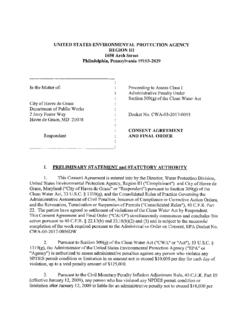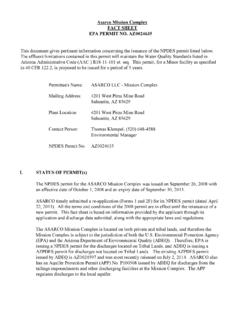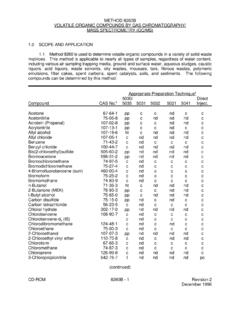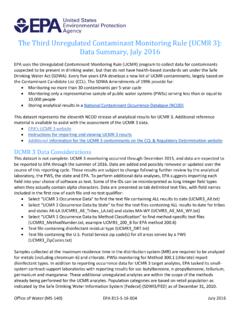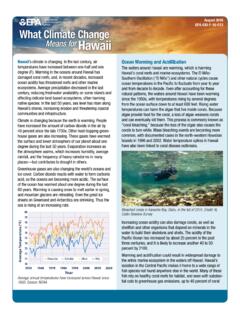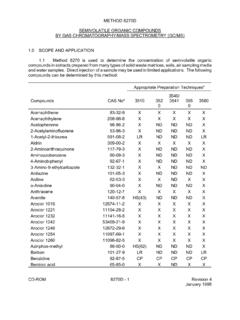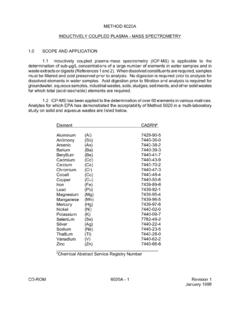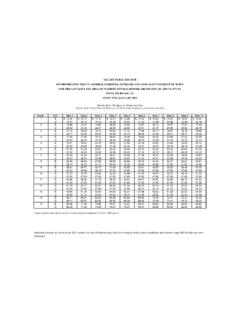Transcription of METHOD 6010C INDUCTIVELY COUPLED PLASMA-ATOMIC …
1 METHOD 6010C INDUCTIVELY COUPLED PLASMA-ATOMIC EMISSION SPECTROMETRY SCOPE AND APPLICATION INDUCTIVELY COUPLED PLASMA-ATOMIC emission spectrometry (ICP-AES) may be used to determine trace elements in solution. The METHOD is applicable to all of the elements listed below. With the exception of groundwater samples, all aqueous and solid matrices require acid digestion prior to analysis. Groundwater samples that have been prefiltered and acidified will not need acid digestion. Samples which are not digested require either an internal standard or should be matrix-matched with the standards. If either option is used, instrument software should be programmed to correct for intensity differences of the internal standard between samples and standards.
2 Refer to Chapter Three for the appropriate digestion procedures. Element Symbol CAS Number Element Symbol CAS Number Aluminum Al 7429-90-5 Mercury Hg 7439-97-6 Antimony Sb 7440-36-0 Molybdenum Mo 7439-98-7 Arsenic As 7440-38-2 Nickel Ni 7440-02-0 Barium Ba 7440-39-3 Phosphorus P 7723-14-0 Beryllium Be 7440-41-7 Potassium K 7440-09-7 Boron B 7440-42-8 Selenium Se 7782-49-2 Cadmium Cd 7440-43-9 Silica SiO2 7631-86-9 Calcium
3 Ca 7440-70-2 Silver Ag 7440-22-4 Chromium Cr 7440-47-3 Sodium Na 7440-23-5 Cobalt Co 7440-48-4 Strotium Sr 7440-24-6 Copper Cu 7440-50-8 Thallium TI 7440-28-0 Iron Fe 7439-89-6 Tin Sn 7440-31-5 Lead Pb 7439-92-1 Titanium Ti 7440-32-6 Lithium Li 7439-93-2 Vanadium V 7440-62-2 Magnesium Mg 7439-95-4 Zinc Zn 7440-66-6 Manganese Mn 7439-96-5 Table 1 lists the elements for which this METHOD has been validated.
4 The sensitivity and the optimum and linear ranges for each element will vary with the wavelength, spectrometer, matrix, and operating conditions. Table 1 lists the recommended analytical wavelengths and estimated instrumental detection limits for the elements in clean aqueous matrices with insignificant background interferences. Other elements and matrices may be analyzed by this METHOD if performance at the concentrations of interest (see Sec. ) is demonstrated. 6010C - 1 Revision 3 November 2000 In addition, METHOD detection limits (MDLs) should be empirically established annually, at a minimum, for each matrix type analyzed (refer to Chapters One and Three for guidance) and are required for each preparatory/determinative METHOD combination used.
5 MDLs are instrument-specific, so an MDL study must be conducted for each instrument in a laboratory. Analysts should clearly understand the data quality objectives prior to analysis and must document and have on file the required initial demonstration performance data described in the following sections prior to using the METHOD for analysis. Analysts should consult the disclaimer statement at the front of the manual and the information in Chapter Two, Sec. , for guidance on the intended flexibility in the choice of methods, apparatus, materials, reagents, and supplies, and on the responsibilities of the analyst for demonstrating that the techniques employed are appropriate for the analytes of interest, in the matrix of interest, and at the levels of concern.
6 In addition, analysts and data users are advised that, except where explicitly specified in a regulation, the use of SW-846 methods is not mandatory in response to Federal testing requirements. The information contained in this METHOD is provided by EPA as guidance to be used by the analyst and the regulated community in making judgments necessary to generate results that meet the data quality objectives for the intended application. Use of this METHOD is restricted to spectroscopists who are knowledgeable in the correction of spectral, chemical, and physical interferences described in this METHOD . SUMMARY OF METHOD Prior to analysis, samples must be solubilized or digested using the appropriate sample preparation methods (see Chapter Three).
7 When analyzing groundwater samples for dissolved constituents, acid digestion is not necessary if the samples are filtered and acid preserved prior to analysis (refer to Sec. ). This METHOD describes multielemental determinations by ICP-AES using sequential or simultaneous optical systems and axial or radial viewing of the plasma. The instrument measures characteristic emission spectra by optical spectrometry. Samples are nebulized and the resulting aerosol is transported to the plasma torch. Element-specific emission spectra are produced by a radio-frequency INDUCTIVELY COUPLED plasma. The spectra are dispersed by a grating spectrometer, and the intensities of the emission lines are monitored by photosensitive devices.
8 Background correction is required for trace element determination. Background emission must be measured adjacent to analyte lines on samples during analysis. The position selected for the background-intensity measurement, on either or both sides of the analytical line, will be determined by the complexity of the spectrum adjacent to the analyte line. The position used should be as free as possible from spectral interference and should reflect the same change in background intensity as occurs at the analyte wavelength measured. Background correction is not required in cases of line broadening where a background correction measurement would actually degrade the analytical result. The possibility of additional interferences identified in Sec.
9 Should also be recognized and appropriate corrections made; tests for their presence are described in Secs. and Alternatively, users may choose multivariate calibration methods. In this case, point selections for background correction are superfluous since whole spectral regions are processed. 6010C - 2 Revision 3 November 2000 DEFINITIONS Refer to Chapter One and Chapter Three for applicable definitions. INTERFERENCES Spectral interferences are caused by background emission from continuous or recombination phenomena, stray light from the line emission of high concentration elements , overlap of a spectral line from another element, or unresolved overlap of molecular band spectra.
10 Compensation for background emission and stray light can usually be conducted by subtracting the background emission determined by measurements adjacent to the analyte wavelength peak. Spectral scans of samples or single element solutions in the analyte regions may indicate when alternate wavelengths are desirable because of severe spectral interference. These scans will also show whether the most appropriate estimate of the background emission is provided by an interpolation from measurements on both sides of the wavelength peak or by measured emission on only one side. The locations selected for the measurement of background intensity will be determined by the complexity of the spectrum adjacent to the wavelength peak.

